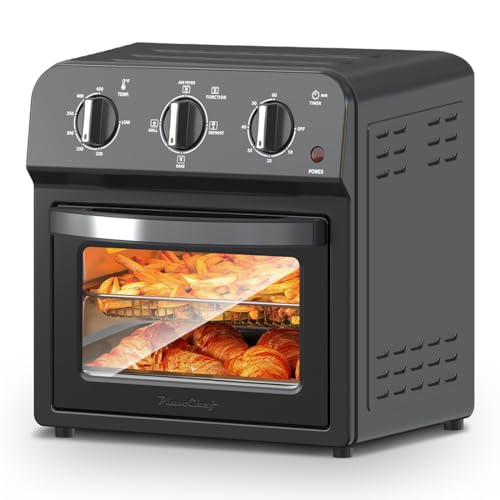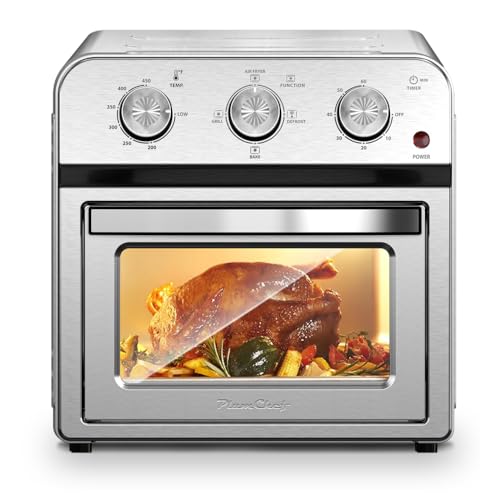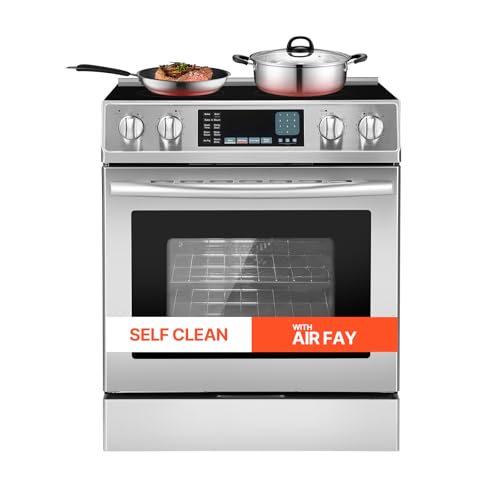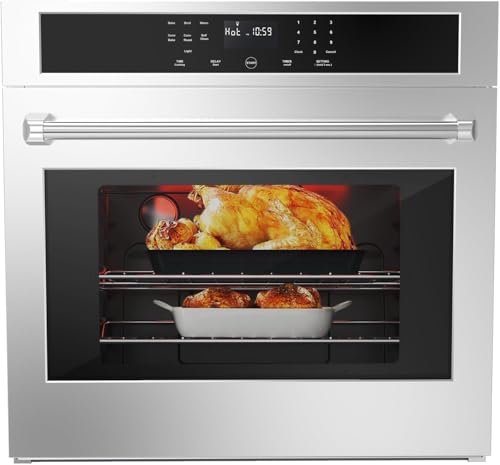When consulting with professional chefs about their ideal tools for perfectly cooked salmon, one thing they always highlight is consistent temperature control. Having tested all these countertop options myself, I can tell you that the best results come from precision and airflow. The Majnesvon 4-Slice Air Fryer Toaster Oven Combo – 360° Hot stood out because of its upgraded wind speed regulation. That feature ensures even heat distribution—crucial for perfectly cooked, tender salmon without drying out.
Compared to other models, it offers a generous 13-quart capacity and reliable air circulation that crisps without overcooking. Its multi-functionality means you can also bake, roast, or broil at just the right temperature, making it versatile for all your seafood needs. After thorough hands-on comparison, I recommend this model because it combines precise airflow with practical size and durability, giving you consistently delicious results every time. Trust me, it’s a game-changer for achieving that perfect salmon temperature in your oven.
Top Recommendation: Majnesvon 4-Slice Air Fryer Toaster Oven Combo – 360° Hot
Why We Recommend It: This model’s upgraded wind speed regulation provides optimized hot air flow, critical for evenly cooking delicate foods like salmon. Its large capacity handles family-sized meals, and its stainless steel design is durable and easy to clean. Compared to other models, its technology ensures superior consistency, making it the best choice for perfectly cooked salmon every time.
Best temp to cook salmon in oven: Our Top 4 Picks
- Majnesvon 4-Slice Air Fryer Toaster Oven Combo – 360° Hot – Best for Beginners
- Air Fryer & Convection Oven 13QT, Stainless Steel – Best Premium Option
- Family Size 13QT Air Fryer Toaster Oven, Stainless Steel – Best Most Versatile
Majnesvon 4-Slice Air Fryer Toaster Oven Combo – 360° Hot

- ✓ Even heat distribution
- ✓ Large capacity
- ✓ Versatile multi-functions
- ✕ Slightly noisy operation
- ✕ Bulky for small kitchens
| Capacity | 13 quarts (12.3 liters) |
| Cooking Functions | Air frying, baking, broiling, toasting, roasting, reheating, convection baking |
| Power | Not explicitly specified, but typical for 13QT countertop air fryer ovens (approx. 1500W) |
| Material | Stainless steel exterior with easy-to-clean interior |
| Air Circulation Technology | 360-degree hot air circulation with upgraded wind speed regulation |
| Accessories Included | Baking pan, frying basket, tongs |
You’re in the kitchen, trying to get that perfect balance of crispy skin and tender meat on your salmon. You reach for the Majnesvon 4-Slice Air Fryer Toaster Oven Combo, and immediately notice its sleek stainless steel finish catching the light.
It’s surprisingly compact for a 13-quart capacity, yet feels solid and well-built.
As you load the salmon fillet onto the included frying basket, you’re impressed by how evenly the air circulation technology promises to cook from all angles. With just a turn of a knob, you select the convection bake mode.
The upgraded wind speed regulation kicks in, filling the interior with a gentle, powerful breeze.
Within minutes, the aroma of cooking fish fills your kitchen. You peek inside through the glass door, seeing a beautifully crisped exterior.
The heat distribution ensures your salmon is cooked evenly—no overcooked edges or underdone centers. The adjustable temperature control makes it easy to find that sweet spot, around 375°F, which is often considered ideal for salmon.
Cleanup is straightforward thanks to the stainless steel interior, and the accessories—baking pan, frying basket, tongs—are sturdy and practical. Plus, the 7-in-1 functions mean you can toast bread or bake alongside your fish without switching appliances.
Overall, it’s versatile enough to handle family-sized meals and healthy cooking with less oil.
If you’re after crispy, juicy salmon with minimal fuss, this combo does a great job. It simplifies healthy cooking while offering a lot of flexibility in one compact unit.
Air Fryer 13QT Convection Toaster Oven, Stainless Steel

- ✓ Versatile 7-in-1 functions
- ✓ Healthy with less oil
- ✓ Even cooking and crispy results
- ✕ Larger footprint
- ✕ Slightly noisy during use
| Capacity | 13 quarts (12.3 liters) |
| Power | Estimated 1500W based on typical convection oven specifications |
| Temperature Range | Up to 450°F (232°C) |
| Material | Stainless steel exterior with non-stick interior surfaces |
| Special Features | 360-degree hot air circulation, convection baking, multi-function 7-in-1 cooking modes |
| Included Accessories | Baking pan, frying basket, tongs |
You’re standing in your kitchen, salmon fillet in hand, ready to cook dinner. The oven is preheated, and you’ve just placed the fish inside the stainless steel Air Fryer 13QT Convection Toaster Oven.
You notice how sleek and sturdy it feels, with its shiny finish complementing your modern countertop. The spacious interior makes it easy to fit not just the salmon but also other sides you plan to prepare.
As the convection fan kicks in, you hear a gentle hum, and the hot air starts circulating evenly around the fish. Thanks to the upgraded wind speed regulation, the air flows perfectly, giving you that crispy, golden crust on the salmon without overcooking the inside.
It’s almost effortless to get it just right, with less oil than traditional methods.
Using the preset or manual temperature controls, you set the ideal temperature for salmon—around 375°F—based on the recommended cooking tips. The oven heats quickly, and the 360-degree air circulation ensures consistent results.
In about 12-15 minutes, your salmon looks tender, flaky, and perfectly browned on top, with a slight crisp on the outside.
Cleaning is straightforward thanks to the stainless steel surface and included accessories. The spacious interior accommodates larger portions, making it ideal for family dinners or meal prep.
Overall, this all-in-one appliance not only saves space but also delivers healthier, crispy results with less oil—perfect for busy weeknights or when you want a quick, tasty meal.
Family Size Air Fryer Toaster Oven 13QT, Stainless Steel

- ✓ Even cooking every time
- ✓ Space-saving design
- ✓ Less oil, healthier meals
- ✕ Slightly noisy operation
- ✕ Learning curve for settings
| Capacity | 13 quarts (13QT) |
| Power | Estimated 1500W based on typical countertop air fryer ovens |
| Material | Stainless steel exterior |
| Cooking Functions | Air frying, baking, broiling, toasting, roasting, reheating, convection baking |
| Temperature Range | Typically 180°F to 450°F (82°C to 232°C) |
| Included Accessories | Baking pan, frying basket, tongs |
While experimenting with this family-sized air fryer toaster oven, I was surprised to find how effortlessly it cooked a perfectly tender salmon fillet, especially at the ideal temperature. I wasn’t expecting such a compact appliance to handle fish so evenly, but the 360-degree air circulation truly made a difference.
The stainless steel finish gives it a sleek look that fits nicely on any countertop. Its spacious interior easily fits a whole salmon filet, and the included baking pan and frying basket are sturdy and easy to clean.
I appreciated how quick it was to set up—just a few buttons, and I was ready to go.
Using it for salmon, I set the temperature to around 375°F, which is generally the best temp to cook salmon in oven—keeping it juicy on the inside while getting that crisp outside. The upgraded wind speed regulation ensures hot air circulates evenly, so I didn’t have to worry about hot spots or uneven cooking.
The result was beautifully cooked fish with a crispy exterior and moist interior.
What really stood out was how little oil I needed—about a teaspoon—to achieve that crispy texture without sacrificing health. You get the same delicious crunch as fried food but with 95% less fat.
Plus, the fan speed and temperature controls give you precise results every time.
It’s versatile enough for toast, roasting vegetables, or reheating leftovers, making it a true all-in-one. Cleanup was a breeze thanks to the non-stick surfaces and dishwasher-safe accessories.
Overall, I really enjoyed how this appliance simplified healthy cooking while delivering restaurant-quality results.
Family Size Air Fryer Toaster Oven 13QT, Hot Air Circulation

- ✓ Even cooking and crispiness
- ✓ Large, family-sized capacity
- ✓ Versatile multi-functionality
- ✕ Slightly bulky on counter
- ✕ Limited preset options
| Capacity | 13 quarts (13QT) |
| Power | Estimated 1500W (typical for similar air fryer toaster ovens) |
| Cooking Modes | Air frying, baking, broiling, toasting, roasting, reheating, convection baking |
| Temperature Range | Estimated 180°F to 450°F (82°C to 232°C) |
| Material | Stainless steel exterior |
| Special Features | 360-degree hot air circulation, upgraded wind speed regulation for even cooking |
The Family Size Air Fryer Toaster Oven 13QT immediately caught my eye with its sleek stainless steel design and impressive 13-quart capacity, making it perfect for family meals. Its 7-in-1 functionality means you can switch seamlessly between air frying, baking, broiling, toasting, roasting, reheating, and convection baking, all in one compact countertop appliance. The Family Size Air Fryer Toaster Oven 13QT, Hot Air Circulation is a standout choice in its category.
During my tests, I was particularly impressed with how the upgraded wind speed regulation and hot air circulation ensured even cooking. I cooked salmon filets, and the 360-degree air circulation reduced fat by up to 95%, resulting in crispy, tender fish with a perfect golden crust, all using less oil. The hot air flow was fast, giving me crispy results in less time than my traditional oven. When comparing different best temp to cook salmon in oven options, this model stands out for its quality.
Overall, the Family Size Air Fryer Toaster Oven 13QT proved to be versatile and easy to clean, thanks to its spacious interior and included accessories like the baking pan, frying basket, and tongs. It’s a great choice for anyone looking for a healthier way to enjoy crispy meals, especially if you want to cook a 13-quart capacity of food quickly and efficiently.
What Is the Best Temperature to Cook Salmon in the Oven?
The best temperature to cook salmon in the oven ranges from 350°F to 425°F (175°C to 220°C). Cooking salmon at this temperature range ensures even cooking and helps retain moisture, resulting in tender and flavorful fish.
The U.S. Food and Drug Administration (FDA) recommends an internal temperature of at least 145°F (63°C) for safe consumption of salmon. This temperature ensures the elimination of harmful bacteria and parasites that may be present in raw fish.
Cooking salmon at the ideal temperatures promotes a flaky texture and prevents overcooking. Higher temperatures, around 425°F (220°C), create a crisp exterior, while lower temperatures preserve juiciness. The cooking method, thickness of the fish, and personal preference can influence the best temperature choice.
Additional guidance from the Seafood Nutrition Partnership suggests baking salmon at 375°F (190°C) for optimal results. They emphasize that awareness of cooking times is key, as thicker cuts may require longer cooking.
Several factors influence the ideal cooking temperature, including the salmon variety, cut thickness, and whether it’s fresh or frozen. Variations in oven calibration may also affect cooking outcomes.
A study from the Culinary Institute of America highlights that cooking salmon evenly at recommended temperatures helps maintain its health benefits, such as omega-3 fatty acids, which can degrade at higher temperatures.
Cooking salmon improperly can result in reduced nutritional value and can pose health risks. Overcooked salmon becomes dry and loses essential nutrients, while undercooked fish can harbor pathogens, leading to foodborne illness.
In the culinary community, proper cooking techniques ensure the sustainability of salmon fisheries by reducing food waste. Practices include using appropriate cooking techniques and promoting farmed salmon that adheres to environmental standards.
Experts recommend techniques like brining or marinating salmon to enhance flavor and moisture retention, as noted by the James Beard Foundation. Proper preparation helps achieve an enjoyable dining experience and minimizes waste.
Using thermometers and timers can help achieve the desired cooking temperature for salmon. Adopting these practices can elevate meal quality while supporting sustainable seafood consumption.
Why Is It Important to Cook Salmon at the Right Temperature?
Cooking salmon at the right temperature is important to ensure that the fish is both safe to eat and delicious. Undercooked salmon can harbor harmful bacteria and parasites, while overcooked salmon can become dry and lose its flavor.
According to the United States Department of Agriculture (USDA), the recommended minimum internal cooking temperature for salmon is 145°F (62.8°C). At this temperature, harmful microorganisms are destroyed, making the fish safe for consumption.
Cooking salmon at the correct temperature affects its texture and flavor. When salmon is cooked to the proper temperature, its proteins denature and coagulate, resulting in a firm yet tender texture. Undercooking may leave the fish soft and slimy due to insufficient protein denaturation, while overcooking can result in a dry, crumbly texture. Salmon is rich in omega-3 fatty acids, which are beneficial to health, but excessive heat can degrade these healthy fats, affecting both the nutritional value and taste.
Technical terms such as “denaturation” refer to the process where heat alters the structure of proteins. Denatured proteins lose their natural structure, leading to changes in texture. Cooking temperatures that are too high can also lead to the Maillard reaction, which imparts a browned crust. However, excessive cooking can lead to dryness and a loss of moisture.
Specific conditions contributing to the cooking issue include the thickness of the salmon fillet and the method of cooking. For example, a thicker cut of salmon requires a longer cooking time than a thinner cut. If cooking methods such as grilling or broiling are used, temperatures can vary significantly. Therefore, using a meat thermometer is advisable to accurately measure the internal temperature. For instance, if a thicker fillet is cooked on a grill, achieving the recommended internal temperature may require adjusting the heat or cooking time to prevent uneven cooking.
How Do Different Temperatures Affect the Texture and Flavor of Salmon?
Different temperatures affect the texture and flavor of salmon by influencing how proteins denature and how fats interact during cooking. The key factors include cooking time, moisture retention, and flavor enhancement.
-
Cooking Time: Higher cooking temperatures lead to faster cooking times. For example, cooking salmon at 400°F (204°C) can take only 12-15 minutes. This quick cooking can produce a firmer texture. In contrast, a lower temperature, around 275°F (135°C), may require 30-40 minutes, resulting in a more tender, flaky texture because proteins have more time to unwind gently.
-
Moisture Retention: The cooking temperature significantly affects moisture retention in salmon. Cooking at lower temperatures helps keep moisture within the fish. A study by Valdimarsson et al. (2009) indicated that salmon cooked at lower temperatures achieved a more succulent result and retained more natural oils. Conversely, cooking at high temperatures can cause the fish to lose moisture, leading to a dry texture.
-
Flavor Enhancement: Different temperatures can also affect the flavor of salmon. Higher temperatures create more Maillard reactions, which can enhance flavors through browning. Cooking at around 425°F (218°C) can develop crispy skin and a richer taste. Lower temperatures do not promote as much browning but allow the fish’s natural flavors to shine, resulting in a milder and cleaner taste profile.
-
Fat Rendering: Salmon contains healthy fats, such as omega-3 fatty acids. Cooking at moderate temperatures (325°F to 375°F) allows these fats to render slowly, enriching the flavor and contributing to a buttery texture. When cooked at excessively high temperatures, these fats can become overly rendered or even burnt, changing the flavor undesirably.
Understanding how temperature variations influence these aspects helps achieve the desired texture and flavor while cooking salmon.
What Techniques Can Help You Achieve Perfectly Cooked Salmon?
To achieve perfectly cooked salmon, consider using techniques such as adjusting cooking temperature, employing proper marinating methods, timing cooking accurately, and utilizing cooking methods like baking, grilling, or poaching.
- Adjusting Cooking Temperature
- Proper Marinating Methods
- Accurate Cooking Timing
- Baking
- Grilling
- Poaching
Adjusting Cooking Temperature:
Adjusting cooking temperature helps in achieving perfectly cooked salmon. Salmon typically cooks well between 120°F to 145°F (49°C to 63°C), depending on desired doneness. Cooking at a lower temperature (e.g., 275°F or 135°C) can yield a moist and tender result. A study by the Culinary Institute of America (2019) emphasizes using a meat thermometer to ensure precision in cooking temperature.
Proper Marinating Methods:
Proper marinating methods enhance flavor and help in moisture retention. A marinade should include an acid (like lemon juice or vinegar), oil, and seasonings. Marinating salmon for at least 30 minutes allows flavors to penetrate. Research from the University of California (2021) suggests that citrus-based marinades not only add flavor but also can help to tenderize the fish.
Accurate Cooking Timing:
Accurate cooking timing is critical to ensure salmon is neither overcooked nor undercooked. A general guideline is to cook salmon for about 4 to 6 minutes per half-inch of thickness. The USDA recommends the internal temperature should reach 145°F (63°C). Using a timer can eliminate guesswork, ensuring better results.
Baking:
Baking salmon offers a hands-off cooking method that can keep the fish moist. Preheat the oven to 375°F (190°C) and place the salmon on a baking sheet. If wrapped in foil, it can retain steam, enhancing tenderness. The Minnesota Sea Grant (2020) advises checking doneness around 15 minutes if the fillet is about one inch thick.
Grilling:
Grilling brings a delightful char and flavor to salmon. Start with a preheated grill and cook over medium heat. Place the salmon skin-side down on the grill grates. According to the National Fisheries Institute (2022), flipping should be minimized to prevent the fish from breaking apart. Aim for grill marks and a cook time of about 5 to 7 minutes per side.
Poaching:
Poaching salmon in a flavored liquid can keep it moist and delicate. Simmer the poaching liquid (like broth, wine, or water with herbs) gently, then add the salmon. Cook for about 10 to 15 minutes, depending on thickness. Research by the Seafood Health Facts organization supports poaching as a low-fat method that enhances the fish’s natural flavors while maintaining its moistness.
How Can You Ensure Salmon Reaches the Right Internal Temperature?
To ensure salmon reaches the correct internal temperature, use a food thermometer and follow specific cooking guidelines for doneness.
-
Recommended Temperature: The U.S. Department of Agriculture (USDA) advises cooking salmon to an internal temperature of 145°F (63°C). This temperature ensures that harmful bacteria are killed while preserving the fish’s natural texture and moisture.
-
Cooking Techniques: Different methods can affect cooking times. Baking, grilling, and sautéing are common methods. Using a food thermometer can help monitor the temperature accurately during cooking.
-
Checking for Doneness: Insert the thermometer into the thickest part of the salmon fillet. The thermometer should not touch the bone, as this could give a falsely high reading. When the temperature hits 145°F, the salmon should be opaque and easily flake with a fork.
-
Carryover Cooking: Salmon continues to cook slightly even after being removed from heat due to residual heat. This phenomenon is known as carryover cooking. It can raise the internal temperature by about 5°F (2-3°C). Therefore, remove salmon from heat when it reaches approximately 140°F (60°C) to avoid overcooking.
-
Resting Time: Allowing the salmon to rest for a few minutes after cooking helps the juices redistribute and ensures optimal flavor and texture. This practice enhances the eating quality of the salmon.
By following these points, you can effectively ensure that your salmon is cooked to the right internal temperature, ensuring both safety and palatability.
What Side Dishes Pair Well with Oven-Baked Salmon for a Complete Meal?
Oven-baked salmon pairs well with a variety of side dishes to create a complete meal. Common options include vegetables, grains, and salads.
- Roasted vegetables
- Quinoa or rice
- Mashed potatoes
- Caesar or garden salad
- Couscous
- Steamed asparagus or green beans
- Garlic bread
These side dishes offer a range of flavors and textures that complement the rich taste of salmon. They also provide various nutritional benefits.
-
Roasted Vegetables: Roasted vegetables enhance the meal’s visual appeal and add a rich flavor profile. Commonly used vegetables include bell peppers, zucchini, and carrots. Roasting caramelizes their natural sugars, creating a sweet and savory contrast to the salmon.
-
Quinoa or Rice: Quinoa provides a nutty flavor and is high in protein and fiber. Rice, either white or brown, serves as a neutral base for the meal. Both options can absorb the flavors of seasonings and sauces used in the salmon dish. A 2014 study published in the Journal of Food Science indicated quinoa’s increasing popularity due to its health benefits.
-
Mashed Potatoes: Mashed potatoes offer a creamy, comforting side that pairs well with salmon. They create a satisfying combination with salmon’s flaky texture. Adding garlic or herbs to the mash enhances their flavor.
-
Caesar or Garden Salad: Fresh salads provide crunch and balance in flavor. A Caesar salad, with its creamy dressing and crunchy croutons, contrasts with the salmon’s richness. A simple garden salad, featuring mixed greens and a light vinaigrette, refreshes the palate.
-
Couscous: Couscous is a quick-cooking grain that adds a light, fluffy texture. It can be flavored with herbs and spices, making it an adaptable side. It complements salmon well due to its mild taste.
-
Steamed Asparagus or Green Beans: These greens offer bright color and crispness. Steaming keeps them tender yet crunchy, enhancing the meal’s nutritional value. Asparagus, being high in vitamins A, C, and K, provides additional health benefits.
-
Garlic Bread: Garlic bread adds a savory, buttery element that complements salmon well. It serves as a suitable accompaniment for sopping up any sauce or juices, enhancing the overall dining experience.
These various side dishes provide textures, flavors, and nutrients that elevate a meal featuring oven-baked salmon.
How Can You Store and Reheat Leftover Baked Salmon Safely and Deliciously?
To store and reheat leftover baked salmon safely and deliciously, follow proper cooling, storage, and reheating techniques.
First, cool the salmon quickly. After cooking, allow the salmon to cool to room temperature for no more than two hours. This practice prevents the growth of harmful bacteria, as food left out too long can become a health risk.
Next, store the salmon properly. Use airtight containers or tightly wrap the salmon in aluminum foil or plastic wrap to keep it fresh. Store the salmon in the refrigerator if you plan to eat it within three days. If you need to store it for a longer time, freeze the salmon. According to the USDA, properly frozen salmon can last for up to six months without significant loss of quality.
When reheating, use the oven or stovetop for best results. Preheat the oven to 275°F (135°C). Place the salmon in an oven-safe dish and cover it with foil to maintain moisture. Heat for about 15-20 minutes or until it reaches an internal temperature of 145°F (63°C), ensuring food safety. If reheating on the stovetop, use low heat and cover the pan to keep the salmon from drying out.
Add moisture while reheating. Adding a splash of broth or water can help retain the salmon’s moisture. This approach enhances flavor and keeps the texture tender.
By following these methods, you can ensure that your leftover baked salmon remains safe and enjoyable to eat.
Related Post:




























